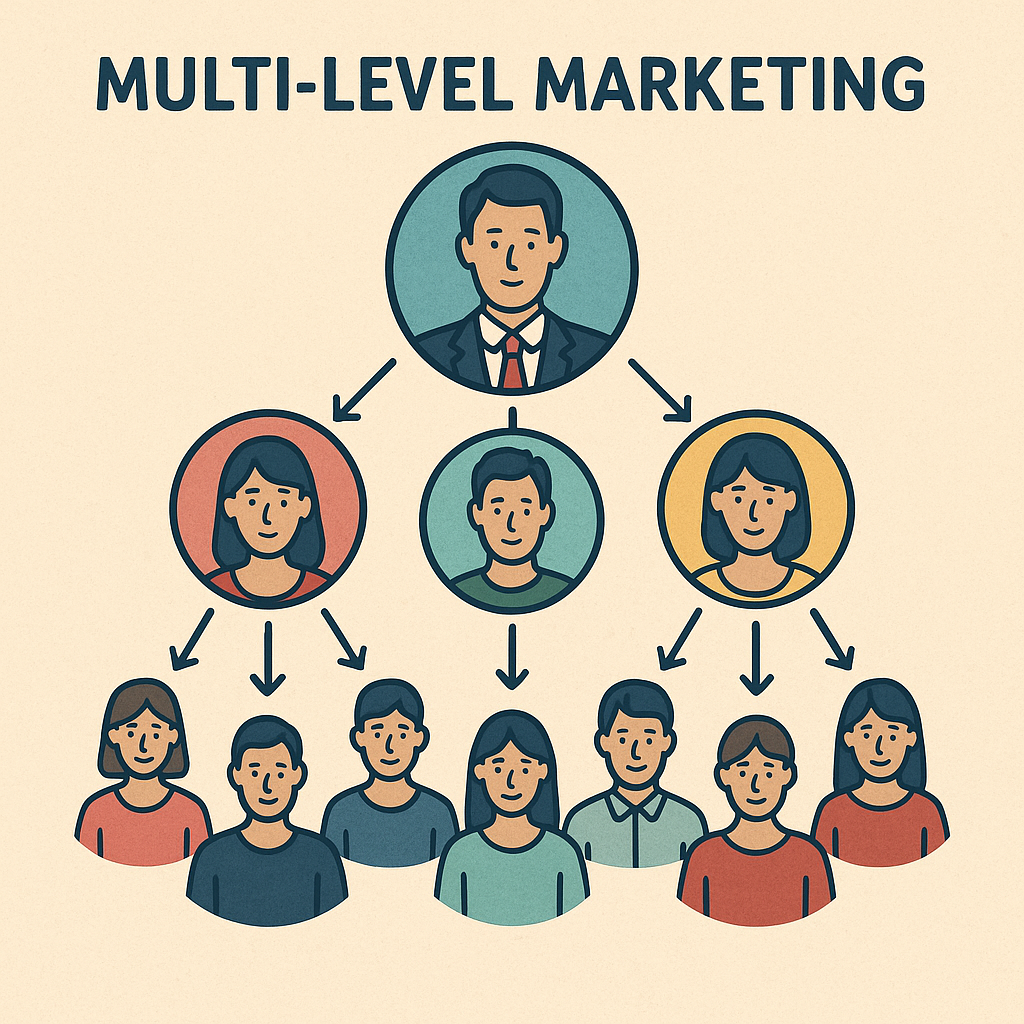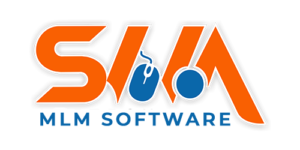Know More About Multi- Level Marketing (MLM)
Multi-Level Marketing (MLM) is a business model where companies sell their products or services directly to consumers, often outside of a traditional retail store. Instead of paying for big advertising campaigns, MLM companies rely on a network of independent distributors (sometimes called associates, members, or representatives) who promote and sell the products.
What is MLM?
Multi-Level Marketing (MLM), sometimes referred to as network marketing or direct selling, is a business model in which people sell goods directly to customers while earning commissions by bringing on new members. The model creates a network of “upline” and “downline” people and rewards both direct and indirect sales from those who are brought into the system.
It is often praised as a means for people to work flexibly, make extra money, and connect with others. However, there have also been issues with regulation, transparency, and broken promises. We must look back in time to see how MLM developed and how technology changed it in order to understand its current state. Then, we can observe how it is currently playing out in India.

History of MLM: Roots and Growth
Early Beginnings
- MLM traces its roots to direct sales long before computers: think door-to-door sales, mail-order catalogs, etc. Some of this model existed in early 20th century businesses.
- Post-World War II, particularly in the 1940s-50s, companies like Nutrilite (founded in 1945) and Amway (1959) formalized MLM structures. In those days, everything was manual like tracking sales, calculating commissions, managing inventory, recording genealogy of distributors in ledgers. Growth was limited by logistics, communication speed and transportation.
1960s-1980s: Spread & Regulation
- More businesses supported MLM/direct-selling as the model showed potential. However, there were many challenges, including doubts, inconsistent legalities across nations, and a lack of uniform regulation.
- Authorities in many locations closely studied MLM against pyramid schemes. The difference between the two is sometimes unclear especially when the focus shifts from selling products to hiring.
1990s-2000s: Formalization & Globalisation
- MLM businesses grew internationally in the 1990s. Additional product categories like beauty, home care, and health and wellness were added.
- Still, a lot of operations continue to use offline strategies, such as meetings, printed advertisements, and local discussions.
- As internet usage spread in popularity in the late 1990s and early 2000s businesses started using email, websites, and simple digital tools like databases and spreadsheets for marketing.
Revolution in MLM Through Technology
Technology has changed MLM in fundamental ways. Here’s how computers, the internet, and later tools transformed MLM.
Computers & Databases
- The first significant change was the use of computers by businesses to track sales, generate commissions, and maintain distributor trees (also called genealogy). No more records written by hand.
- Orders, product inventory, and distributor information were managed with the support of simple database tools like MS Access, Fox Pro, dBASE, and others. This improved accuracy, decreased disagreements, and made scaling possible.
Web & Internet
- The internet gave rise to business websites and distributor sites where you could place orders, monitor commissions, and view your network’s figures. Transparency and trust were raised as a result.
- E-commerce integrations like gateways could be used to process payments and place product orders online. Cross-region shipping is an option for products. Digital marketing was used for online ads, banners, and emails.
Mobile & Social Media
- MLM businesses changed with social media marketing, WhatsApp, and mobile apps as smartphones developed. Distributors could more quickly and widely share product information. training videos through groups on WhatsApp and facebook ads.
- Word-of-mouth spreads quickly thanks to social networks. Influencer marketing and testimonials were helpful.
Cloud, Analytics & Automation
- Cloud-based MLM software (SaaS) means companies don’t need massive on-premise tech infrastructure.
- Automated commission payouts, automated rank, bonus calculation, real-time reports.
- Analysis for estimating revenue, estimating employee turnover, finding top distributors, and understanding product performance.
New Frontiers: Blockchain, Smart Contracts, AI
- Some multilevel marketing (MLM) schemes and similar “MLM-like” schemes have experimented with blockchain in recent years for transparent commission and sales tracking and permanent records.
- AI is helping distributors with content creation, lead scoring, and personalised marketing.
- Not all of this is widespread in India yet, but globally these are emerging.
India’s Top 10 MLM Companies – Overview & Revenue
The top direct selling and Multilevel Marketing Companies in India are listed in the table below. What is known is shown in the table, along with the year of establishment, recent earnings, and losses if available frequently not disclosed.
| Rank | Company | Year Established | Recent Turnover / Revenue (India) | Recent Loss (if any or Notes) |
| 1 | Amway India | 1959 (global) / active India since ~1990s | ~ ₹ 6,000+ crore in 2024 (approx) | N/A publicly disclosed |
| 2 | Vestige Marketing Pvt. Ltd. | 2004 | ~ ₹ 3,000+ crore (2024) | N/A |
| 3 | Herbalife India | 1980 | ~ ₹ 2,000+ crore (2024) | N/A |
| 4 | Modicare | 1996 | ~ ₹ 2,700 crore (2024) | N/A |
| 5 | Forever Living Products India | 1978 | Not clearly in crores in some sources; but strong revenue globally; Indian revenues significant; as per some sources ~ ₹ hundreds of crores range. | N/A |
| 6 | Mi Lifestyle Marketing Global Pvt. Ltd. | 2013 | ~ ₹ 1,500 crore in 2024 | N/A |
| 7 | Oriflame India | 1967 | Over ₹ 500+ crore or more in some sources; strength in cosmetics & beauty. | N/A |
| 8 | Avon India | (Founded globally 19th century / established India ~1990s) | Revenue in India is substantial; in top MLMS, though exact recent numbers in crores varied; in earlier lists > INR 500 cr level. | N/A |
| 9 | RCM (Right Concept Marketing) | ~1988 | ~ ₹ 1,600-₹ 2,000+ crore (FY 2022 or recent) | N/A |
| 10 | DXN India | 1993 | ~ ₹ 700+ crore (Recent) per some sources | N/A |
Notes: “crore” is 10 million; ₹ = Indian Rupee. Figures are approximate and based on public sources. Loss data is generally not available or not disclosed; many are privately held.
Turnover Trends of Top MLMs in India Over Last ~20 Years
Getting exact 20-year financials for all MLMs is difficult because many are private, and earlier years did not always publish consistent turnover figures. But some trends and key points emerge:
- Slow beginnings, exponential growth
- Early 2000s MLM and direct selling were spread out and smaller in India. Businesses such as Amway and Oriflame had existed, but on a small scale..
- Acceptance increased between the mid-2000s and the 2010s due to factors like growing middle class, internet access, regulatory clarity (Direct Selling Guidelines, etc.), and people’s increased comfort level with wellness, health, and beauty products.
- Regulation played a role
- Several states passed laws related to direct selling, and the Indian government issued guidelines for the practice in many of them. This gave it authority and encouraged businesses to release more information.
- Rules to distinguish between MLM / direct selling vs pyramid scheme helped weed out bad actors.
- Tech adoption accelerated revenue
- As companies started using digital tools to reach distributors, to train them, to do e-commerce, turnover grew faster. For example, Vestige, Modicare, Herbalife and others showed double digit growth in certain years.
- By FY2022, companies like Herbalife India reported turnover ~ ₹ 3,281 crore.
- RCM (~₹ 1,660 crore) and Amway (~₹ 1,733 crore) also featured in similar ranges in FY 2022.
- Recent numbers (2022-2024)
- Amway India: around ₹ 6,000+ crore (2024)
- Vestige: ~ ₹ 3,000+ crore (2024)
- Modicare: ~ ₹ 2,700 crore (2024)
- Herbalife India: ~ ₹ 2,000+ crore (2024)
- Loss / Decline Years
- Because of competition, regulation, the pandemic (COVID-19), supply chain issues, and shifts in consumer behaviour, some years saw stagnation or decline in growth.
- Also, many of the older companies had to modernize; companies that did not adopt tech fell behind.
So overall, over the last 20 years, the Indian MLM sector has gone from small, mostly localized players to large, modern companies with revenues in hundreds to thousands of crores annually for the top companies.
Challenges & What Next
While the growth has been impressive, several important challenges persist, and they are shaping what comes next.
- Regulatory clarity: Laws vary between states, and enforcement is inconsistent. Some companies still get accused of being pyramid schemes. Clarity in direct selling / MLM laws helps build trust.
- Transparency and trust: Distributors often demand better transparency in commission plans, stock inventory and claims. Technology helps here but not all companies are equal.
- Technology-gap: Older MLM companies may lag in digital adoption; distributors expect tools, mobile interfaces, analytics, online order fulfillment.
- Competition & product relevance: Consumer tastes change; wellness, natural products, social media marketing are big. Companies must keep innovating.
- Economic pressures: Inflation, logistics costs, disruptions like pandemics, plus digital market competition (e-commerce platforms) put pressure on margin and distributor retention.

How Companies Do Fake Commitment to Their Clients
- Overpromising Services: Organisations make false assurances about high-quality services or fast outcomes.
- Hidden Terms – While appealing deals are promoted, customers find it difficult to take advantage of the terms and conditions in reality.
- Fake Promises: Terms such as “lifetime warranty” or “100% money back” are used, but claims are consistently rejected or postponed.
- Impractical Deadlines: Companies rarely fulfil the demanding delivery dates they set in an attempt to impress customers.
- Manipulated Data: Businesses display fictional client lists, success rates, or performance metrics.
- Lack of Customer Service: Despite their promises of “24/7 support,” they rarely or never offer help.
- Pricing misrepresentation: Although initial quotes appear low, later charges and additional fees appear.
- Psychological Advertising: They apply sentimental words like “we treat you like family” without actually caring about how satisfied their customers are.
- Postponing Strategies: When customers request updates, the business basically responds with statements like “work is in progress” without taking any practical steps.
- Neglected After-Sales Service: Businesses make promises of additional support but then disappear after the sale is completed.
Fake commitments may attract customers at first, but they destroy trust and brand reputation in the long run. Genuine companies focus on transparency, realistic promises, and delivering consistent results.
SWA MLM Software – Powering the Next Generation of MLM Companies
Behind every successful MLM company today is powerful and reliable MLM software. One such leading provider is Best MLM Software Company. They are known for delivering advanced, secure, and user-friendly MLM solutions that help companies manage their entire business with ease.
SWA MLM Software offers features like:
- Real-time commission and payout management
- AI-powered lead management system
- Interactive dashboards for distributors
- Mobile-friendly Webview application
- Automated training modules
- Secure and General Data Protection Regulation (GDPR)-compliant data management
Some of our reputed companies in India trust SWA MLM Software from the last more than 5 years of operations. Among them are:
- SAPL – A leading direct selling brand in wellness.
- NUTRIMA – Known for high-quality nutrition products.
- NEEM BIOTECH – Focused on organic and herbal solutions.
- DREAMERS INDIA – A fast-growing company in the lifestyle segment.
By providing advanced digital solutions, SWA MLM Software helps these companies save time, reduce errors, and grow faster in a competitive market.
Conclusion
Multi-Level Marketing (MLM) has come a long way from its door-to-door sales beginnings to becoming a technology-driven business model with global reach. In India, companies like Amway, Vestige, Modicare, and Herbalife have built strong networks and generated revenues in thousands of crores, supported by better regulations and advanced MLM software solutions.
However, challenges such as regulatory clarity, transparency, product innovation, and customer trust remain at the center of MLM’s growth. While some companies still make fake promises, the true success of MLM lies in authentic business practices, quality products, and powerful technology solutions like SWA MLM Software that empower distributors and companies alike.
As the MLM industry in India continues to evolve with AI, blockchain, and digital transformation, the future looks promising for those who focus on integrity, technology, and customer satisfaction.
FAQs
Q1. What is the difference between MLM and a pyramid scheme?
MLM involves selling genuine products/services and paying commissions on sales. A pyramid scheme mainly rewards recruitment without actual product sales, making it illegal.
Q2. Can MLM be a full-time career in India?
Yes, but success depends on effort, product demand, company reputation, and team-building skills. Many people use it as a side income initially.
Q3. Is MLM legal in India?
Yes, MLM is legal if it follows the Direct Selling Guidelines 2016 and other government norms. Companies must focus on product sales, not just recruitment.
Q4. What are the risks of joining an MLM company?
Risks include false promises, lack of transparency, overpricing of products, and the possibility of the company operating as a pyramid scheme. Always research the company before joining.
Q5. How has technology changed MLM?
With MLM software, mobile apps, cloud solutions, AI, and blockchain, companies can manage payouts, networks, inventory, and distributor training more efficiently than ever before.

